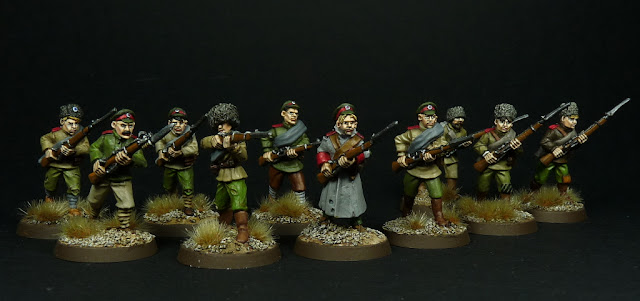He has little outside help - the British cannot risk alienating their Chinese friends by openly supplying Annenkov with weapons - but receives some assistance from the Japanese. He can also count on the ferociously anti-Chinese Tibetans.
Regular Infantry
Annenkov's regular White infantry, be they volunteers or conscripts, form the backbone of his army. Having fought their way out of Russia, many have a long experience of combat which counterbalances their poor equipment.
Naval Infantry
Although a large part of the navy rallied the Bolchevik cause, some fought alongside the White Russians. This small contingent of naval infantry is now far from any shore, but provides a unit of elite infantry to defend Urumchi.
Partisans
Civilians played an active role in the anti-Bolchevik counter-revolution, and Annenkov can count on thousands of armed civilians, drawn from the Russian population settled around Urumchi, or sometimes coming down from the border. These civilians are often stiffened by demobilised soldiers or deserters from World War One, and hence have some limited military organisation. They lack however good equipment, and often even decent clothing.
Copplestone
Tibetan Mercenaries
Many Tibetans are traditionally given over to raiding Chinese territory, and the War of Sinkiang has only increased their opportunities. The Dalai Lama, who is actively anti-Chinese, openly encourages his kinsmen to take part in the war against Kashgar.
Copplestone
Chinese bandits
With the Chinese Warlord period at its peak, large bandit groups rove through Chinese Turkestan and will fight for whomever offers the highest wages or the greater hope of plunder.
Copplestone
Véhicules
Annenkov arrived at Urumchi with two armoured cars, but other than that he has no other combat vehicles, and very little transport.
Unknown manufacturer











Une période très intéressante et une magnifique collection!
RépondreSupprimerExcellent work!
RépondreSupprimerThank you very much !
RépondreSupprimer